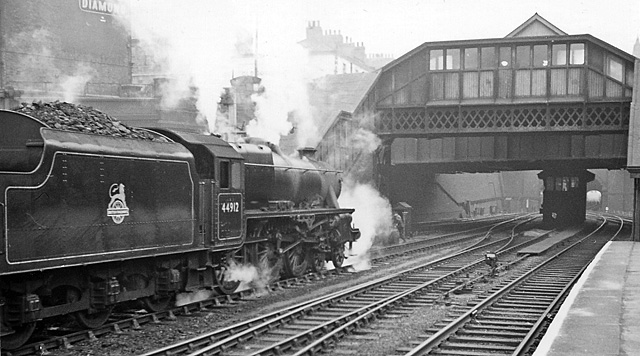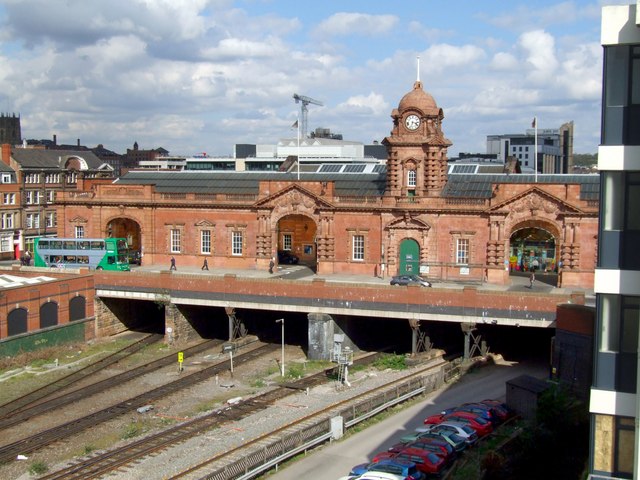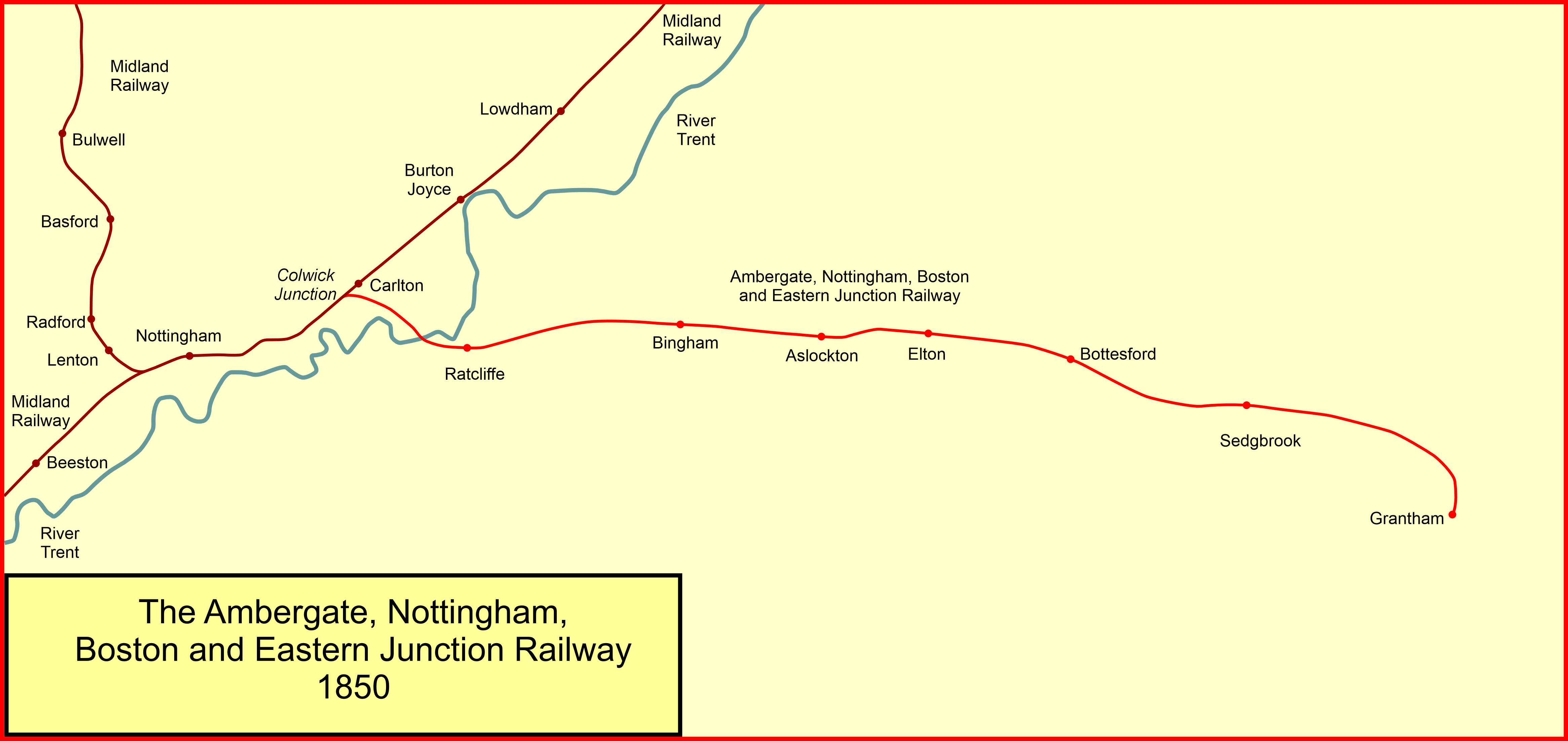|
Nottingham Carrington Street Railway Station
Nottingham Carrington Street railway station was the first railway station in Nottingham, opened in 1839 by the Midland Counties Railway. Initially there were two lines with a central platform as well as side ones according to Billson. Victorian civil engineer Francis Whishaw described the station as: "The elevation next to the road to Nottingham is of plain but neat design. It consists of a central portion and two wings; the central portion contains the entrance hall, which is of the whole height of the building. In the right wing is the booking office for first and second class passengers, with windows (looking to the hall) at which the passengers receive their tickets; the third class passengers obtain their tickets at a counter fixed in the hall. In the left-wing is the boardroom and clerks offices; and in a building projecting towards the passenger shed in the rear is a waiting room for ladies.'' The rainshed is covered with a light iron roof in two spans, which is supp ... [...More Info...] [...Related Items...] OR: [Wikipedia] [Google] [Baidu] |
Carrington Railway Station
Carrington railway station was a railway station in Nottingham on the Great Central Railway main line, the last main line to be built from the north of England to London. The station opened with the line on 15 March 1899, and served the Nottingham suburb of Carrington until 1928. History The station was opened by the Great Central Railway on its London Extension and was one of only two original stations on the line to have its platforms on each side, rather than having a single central island. It served a relatively affluent residential area about a mile to the north of the city centre along the Mansfield Road, and thus was popular with business people, and was built in a deep cutting 154 yards (140 metres) in length between the Sherwood Rise and Mansfield Road Tunnels. Had it not been for Carrington station the line would have remained underground here. There were small waiting rooms on the platforms, but the booking office and main buildings were at street level with a lo ... [...More Info...] [...Related Items...] OR: [Wikipedia] [Google] [Baidu] |
Lincoln, Lincolnshire
Lincoln () is a cathedral city, a non-metropolitan district, and the county town of Lincolnshire, England. In the 2021 Census, the Lincoln district had a population of 103,813. The 2011 census gave the urban area of Lincoln, including North Hykeham and Waddington, a population of 115,000. Roman ''Lindum Colonia'' developed from an Iron Age settlement on the River Witham. Landmarks include Lincoln Cathedral (English Gothic architecture; for over 200 years the world's tallest building) and the 11th-century Norman Lincoln Castle. The city hosts the University of Lincoln, Bishop Grosseteste University, Lincoln City FC and Lincoln United FC. Lincoln is the largest settlement in Lincolnshire, with the towns of Grimsby second largest and Scunthorpe third. History Earliest history: ''Lincoln'' The earliest origins of Lincoln can be traced to remains of an Iron Age settlement of round wooden dwellings, discovered by archaeologists in 1972, which have been dated to the first cen ... [...More Info...] [...Related Items...] OR: [Wikipedia] [Google] [Baidu] |
Railway Stations In Great Britain Opened In 1839
Rail transport (also known as train transport) is a means of transport that transfers passengers and goods on wheeled vehicles running on rails, which are incorporated in tracks. In contrast to road transport, where the vehicles run on a prepared flat surface, rail vehicles (rolling stock) are directionally guided by the tracks on which they run. Tracks usually consist of steel rails, installed on sleepers (ties) set in ballast, on which the rolling stock, usually fitted with metal wheels, moves. Other variations are also possible, such as "slab track", in which the rails are fastened to a concrete foundation resting on a prepared subsurface. Rolling stock in a rail transport system generally encounters lower frictional resistance than rubber-tyred road vehicles, so passenger and freight cars (carriages and wagons) can be coupled into longer trains. The operation is carried out by a railway company, providing transport between train stations or freight customer facilit ... [...More Info...] [...Related Items...] OR: [Wikipedia] [Google] [Baidu] |
Nottingham Victoria Railway Station
Nottingham Victoria railway station was a Great Central Railway and Great Northern Railway railway station in Nottingham, England. It was designed by the architect Albert Edward Lambert, who also designed the rebuild of the Nottingham Midland station (now known simply as Nottingham station). It was opened by the Nottingham Joint Station Committee on 24 May 1900 and closed on 4 September 1967 by the London Midland Region of British Railways. The station building was entirely demolished (except the clock tower), and the Victoria Centre shopping centre was built on the site, incorporating the old station clock tower into the main entrance on Milton Street (the continuation of Mansfield Road). Background In 1893 the Manchester, Sheffield and Lincolnshire Railway obtained authorisation to extend its North Midlands railway network into London. This new line was opened on 15 March 1899 (by which time the railway company was known as the Great Central Railway) and became known as the ... [...More Info...] [...Related Items...] OR: [Wikipedia] [Google] [Baidu] |
Nottingham Magistrates' Court
Nottingham Magistrates' Court is a magistrates' court in Nottingham, England. History Until 1996, Nottingham magistrates were housed in two separate buildings, the Guildhall and the Shire Hall. In 1996, all magistrates were moved to the new Nottingham Magistrates' Court building, and the old buildings were closed. The Shire Hall subsequently was converted into the Galleries of Justice. The Nottingham Guildhall is occupied by Nottingham City Council. Description The building was designed by the Nottingham County Council Architect's Department with William Saunders Partnership and Cullen, Carter and Hill.Pevsner Architectural Guides. Nottingham. Yale University Press. . It sits on the site of Nottingham Carrington Street railway station and the gateposts still frame the pathway from Carrington Street to the court. There are 18 courtrooms in the main block, with six courtrooms in the Youth and Family block. The complex of buildings also includes the Bridewell Police Station. ... [...More Info...] [...Related Items...] OR: [Wikipedia] [Google] [Baidu] |
Nottingham Railway Station
Nottingham station, briefly known as Nottingham City and for rather longer as Nottingham Midland, is a railway station and tram stop in the city of Nottingham. It is the principal railway station of Nottingham. It is also a nodal point on the city's tram system, with a tram stop that was originally called Station Street but is now known as Nottingham Station. The station was first built by the Midland Railway (MR) in 1848 and rebuilt by the same company in 1904, with much of the current building dating from the later date. It is now owned by Network Rail and managed by East Midlands Railway (EMR). Besides EMR trains, it is also served by CrossCountry and Northern trains and by Nottingham Express Transit (NET) trams. The station was one of several that once served the city of Nottingham. Amongst these were the city centre stations of on the Great Central Railway, and on the Great Northern Railway; both of these stations are now closed. A number of minor stations served l ... [...More Info...] [...Related Items...] OR: [Wikipedia] [Google] [Baidu] |
Ambergate, Nottingham, Boston And Eastern Junction Railway
The Ambergate, Nottingham and Boston and Eastern Junction Railway was a British railway company, which hoped to connect Lancashire with the port of Boston, in Lincolnshire. It was authorised in 1846 but was unable to raise much money. It opened a standard gauge line from a junction near Nottingham to Grantham in 1853. At Nottingham it was to rely on the Midland Railway, but that company was hostile and obstructive. The Ambergate company was leased to the Great Northern Railway in 1855, and they built their own Nottingham station, opened in 1857. In 1860 the company changed its name to the Nottingham and Grantham Railway and Canal Company. In 1875 the Great Northern Railway opened a line into Derbyshire and the former Nottingham to Grantham line became an important trunk route, particularly for goods and mineral traffic. The original line from Colwick to Grantham is still in use as the Nottingham–Grantham line. The freight traffic has greatly diminished, but the line is used f ... [...More Info...] [...Related Items...] OR: [Wikipedia] [Google] [Baidu] |
Mansfield
Mansfield is a market town and the administrative centre of Mansfield District in Nottinghamshire, England. It is the largest town in the wider Mansfield Urban Area (followed by Sutton-in-Ashfield). It gained the Royal Charter of a market town in 1227. The town lies in the Maun Valley, north of Nottingham and near Sutton-in-Ashfield. Most of the 109,000 population live in the town itself (including Mansfield Woodhouse), with Warsop as a secondary centre. Mansfield is the one local authority in Nottinghamshire with a publicly elected mayor. History Roman to Mediaeval Period Settlement dates to the Roman period. Major Hayman Rooke in 1787 discovered a villa between Mansfield Woodhouse and Pleasley; a cache of denarii was found near King's Mill in 1849. Early English royalty stayed there; Mercian Kings used it as a base to hunt in Sherwood Forest. The Royal Manor of Mansfield was held by the King. In 1042 Edward the Confessor possessed a manor in Mansfield. William the Conqu ... [...More Info...] [...Related Items...] OR: [Wikipedia] [Google] [Baidu] |
North Midland Railway
The North Midland Railway was a British railway company, which opened its line from Derby to Rotherham (Masbrough) and Leeds in 1840. At Derby, it connected with the Birmingham and Derby Junction Railway and the Midland Counties Railway at what became known as the Tri-Junct Station. In 1844, the three companies merged to form the Midland Railway. Origin The East Midlands had for some years been at the centre of plans to link the major cities throughout the country. In Yorkshire, George Hudson was the Chairman of the York and North Midland Railway, a proposed line from York towards the industrial markets of Manchester and Liverpool. The new line would connect it, and the Manchester and Leeds Railway as part of a trunk route from the South and London to Yorkshire and the North East of England. Meanwhile, financiers in Birmingham, were looking to expand their system northwards. George Carr Glyn was the first Chairman of the new company, with George Stephenson appointed as engi ... [...More Info...] [...Related Items...] OR: [Wikipedia] [Google] [Baidu] |
Carrington Street, Nottingham
Carrington Street is a street in Nottingham city centre between Nottingham station and Broadmarsh. History The street was laid out by Henry Moses Wood, Surveyor in 1828. The opportunity offered by the construction of this new road was taken to install a large culvert in circumference as a storm drain, to carry water to the River Leen. The River Leen was dredged by approximately to provide additional capacity. In 1842 a bridge was constructed over the Nottingham and Beeston Canal to provide access to Nottingham Carrington Street railway station. The bridge costing £6,000 () was partly sponsored by the Midland Counties' Railway. It contained an inscription which read: This bridge was commenced in August, 1841, J.M.B. Pigot M.D., Mayor, and completed in October, 1842, R. Morley Esq., Mayor, H.M. Wood, Architect. The bridge was widened in 1904 when the new Nottingham station was erected. Having crossed the canal, the street arrived at Nottingham Carrington Street railway stat ... [...More Info...] [...Related Items...] OR: [Wikipedia] [Google] [Baidu] |





